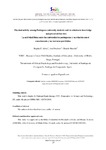Mostrar o rexistro simple do ítem
Physical Activity Among Portuguese University Students and Its Relation to Knowledge and Perceived Barriers
| dc.contributor.author | Alves, Regina | |
| dc.contributor.author | Precioso, J. | |
| dc.contributor.author | Becoña, Elisardo | |
| dc.date.accessioned | 2021-03-26T09:28:23Z | |
| dc.date.available | 2021-03-26T09:28:23Z | |
| dc.date.issued | 2021-01-01 | |
| dc.identifier.citation | Alves, R., Gomes Precioso, J. A., & Becoña Iglesias, E. (2021). Physical activity among Portuguese university students and its relation to knowledge and perceived barriers. Sportis. Scientific Journal of School Sport, Physical Education and Psychomotricity, 7(1), 25-42. https://doi.org/10.17979/sportis.2021.7.1.6924 | es_ES |
| dc.identifier.issn | 2386-8333 | |
| dc.identifier.uri | http://hdl.handle.net/2183/27602 | |
| dc.description.abstract | [Abstract] University students, regardless of the country, have a very high prevalence of physical inactivity and health habits acquired during this period tend to remain throughout life, including those related to physical exercise. The purpose of this study was to analyse the relationship between knowledge about the recommendations on the practice of physical activity (PA), the perceived barriers towards PA and the practice of PA by higher education students. This cross-sectional study used a self-reported questionnaire with a stratified sample of university students (n = 840) from a university in Portugal. An ordinal logistic regression model was calculated to determine the predictive variables to the practice of PA. The results showed that 35.7% of the students surveyed were sedentary, the level of knowledge about PA was low, correctly answering 2.79 (SD = .090) questions in a total of 6, and lack of time was the most evident perceived barrier. The constructed model predicted that having more barriers to PA (β = -.750, p = .000) and being female decreased the likelihood of practising PA (β = .578, p = .000). The increase of PA levels of university students is a social necessity and, in this context, higher education institutions should undertake a key role in promoting student health, by implementing actions to reduce their students’ inactivity, developing the transmission of information about the health benefits related to the practice of PA. | es_ES |
| dc.description.abstract | [Resumen] Los estudiantes universitarios, independientemente del país, tienen una prevalencia muy alta de inactividad física y los hábitos de salud adquiridos durante este período tienden a permanecer a lo largo de la vida, incluidos los relacionados con el ejercicio físico. El propósito de este estudio fue analizar la relación entre el conocimiento sobre las recomendaciones sobre la práctica de AF, las barreras percibidas hacia AF y la práctica de AF por estudiantes de educación superior. Este estudio transversal utilizó un cuestionario auto informado con una muestra estratificada de estudiantes universitarios (n = 840) de una universidad de Portugal. Se calculó un modelo de regresión logística ordinal para determinar las variables predictivas para la práctica de AF. Los resultados mostraron que el 35,7% de los estudiantes encuestados eran sedentarios, el nivel de conocimiento sobre AF era bajo, respondiendo correctamente 2,79 (DE = .090) preguntas en un total de 6, y la falta de tiempo era la barrera percibida más evidente. El modelo construido predijo que tener más barreras a la AF (β = -.750, p = .000) y ser mujer disminuyó la probabilidad de practicar AF (β = .578, p = .000). El aumento de los niveles de AF de los estudiantes es una necesidad social y las instituciones deben asumir un papel clave en la promoción de la salud del alumnado, mediante la implementación de acciones para reducir la inactividad de sus estudiantes, desarrollando la transmisión de información sobre los beneficios para la salud. relacionados con la práctica de la AF. | es_ES |
| dc.description.sponsorship | Fundação para a Ciência e a Tecnologia (Portugal); SFRH / BD / 120758/201 | es_ES |
| dc.language.iso | eng | es_ES |
| dc.publisher | Universidade da Coruña | es_ES |
| dc.relation.uri | https://doi.org/10.17979/sportis.2021.7.1.6924 | es_ES |
| dc.rights | Atribución-CompartirIgual (CC BY-SA) 4.0 Internacional | es_ES |
| dc.rights.uri | https://creativecommons.org/licenses/by-sa/4.0/deed.es | |
| dc.subject | Ejercicio físico | es_ES |
| dc.subject | Universidad | es_ES |
| dc.subject | Práctica de actividad física | es_ES |
| dc.subject | Jóvenes-adultos | es_ES |
| dc.subject | Barreras percibidas | es_ES |
| dc.subject | Physical exercise | es_ES |
| dc.subject | Knowledge | es_ES |
| dc.subject | Perceived barriers | es_ES |
| dc.subject | Recommendations | es_ES |
| dc.subject | University students | es_ES |
| dc.title | Physical Activity Among Portuguese University Students and Its Relation to Knowledge and Perceived Barriers | es_ES |
| dc.title.alternative | La actividad física entre los universitarios portugueses y su relación con el conocimiento y las barreras percibidas | es_ES |
| dc.type | info:eu-repo/semantics/article | es_ES |
| dc.rights.access | info:eu-repo/semantics/openAccess | es_ES |
| dc.date.updated | 2021-03-25T08:51:22Z | |
| UDC.journalTitle | Sportis. Scientific Journal of School Sport, Physical Education and Psychomotricity | es_ES |
| UDC.volume | 7 | es_ES |
| UDC.issue | 1 | es_ES |
| UDC.startPage | 25 | es_ES |
| UDC.endPage | 42 | es_ES |
| dc.identifier.doi | 10.17979/sportis.2021.7.1.6924 |






